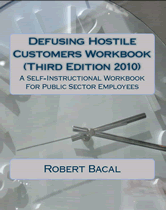
Where TQM & Politics Clash
Last December, I had the opportunity to chat with a friend who works for a major Canadian consulting firm in the area of quality improvement, i asked him whether his company worked with public sector clients. He replied that while his company felt that this market would be lucrative, he also indicated that the government environment was difficult to manage. In particular, he mentioned two things: governments are too slow to make the commitment to quality improvement, and they are unwilling to embrace the concept that it takes an investment of time and money to improve a system as large as government. Doubtless, if he had more experience working with governments, he would have mentioned others.
The truth is that TQM and politics do clash. It doesn't have to be this way, but it is. We are going to look at a few realities of the political system as they relate to improving processes within government.
The Political Context
Briefly, we can characterize the current political context of government as follows:
- tends to focus on short-term activities that do not fundamentally change systems (emphasis on the quick fix)
- crisis driven rather than preventative
- driven by current economic conditions rather than long-term conditions
- characterized by mistrust between political and civil service arms of government
- top-down decision making prevalent
- highly adversarial positions of political parties
These conditions stem as much from the way our political system is structureci rather than the specific players in the game. You can shuffle the politicians any way you wish, but the system itself, focuses even well-meaning politicians on a short term perspective that can be hostile to the improvement of processes. In the absence of exceptional political leadership, these conditions will hold.
The
#1 Clash - Cost Reduction Driven
When a TQM initiative is "sponsored" by the political arm of government, it tends to exist on a foundation of crisis oriented cost reduction. With the current economic conditions it isn't surprising that politicians are searching for ways to reduce expenditures, as public pressure for service AND reasonable taxes increases.
However, quality improvement and cost cutting initiatives are not the same. When the two are confused, and seen as equivalent, problems result on the implementation side. When politicians, intent on budget reduction, introduce a quality improvement process to serve ti~at end, an atmosphere of fear and mistrust is created that at least, initially, reduces the willingness of managers and employees to work together to achieve these ends. And while it is important to have high level commitment to the process, quality improvement will succeed or fail to the degree that employees see that it is in their own self-interest. When the political arm makes it clear that the goal is to reduce expenditures, employees identify quality improvement as a threat to their continued employment, or the stability of their jobs. It is unreasonable to expect that employees will search diligently for ways to improve processes when those improvements might result in their own employment being terminated. Even when the possibility of staff reductions is remote, the emphasis on cost reduction creates the perception of threat.
The problem is one of perception rather than reality.
A Solution - Leadership
In a more perfect world, we would hope that politicians would take the long term view to organizational improvement. We would hope that politicians would spend months learning about TQM, and develop an awareness that driving the process with a cost- cutting whip is likely to destroy the process. In a perfect world! We would also hope that politicians would support improvement by developing financial systems that do not penalize people for cutting waste or becoming more efficient. Maybe this shift in perspective will occur down the road, but right now, we don't have the perfect world.
So, what do we do until then? While the context of a quality improvement initiative is influenced by the political arm of government, it is not completely determined by politicians. Fortunately, employees take their cues from the actions of those that they see every day, the managers, supervisors and other quality change leaders. If these leaders can prove that quality improvement is in the best interests of both employees and customers, we think it is possible to partially counteract the sense of threat that comes from the specter of cost and staff reduction. Below are some tips to help you promote a positive vision of duality improvement within a political government context. Note that these tips are applicable regardless of whether the initiative is sponsored by politicians or whether it is initiated at a more local level.
Promoting A Positive Vision of Quality
Never
Lie!
Keep in mind that you may be working within a climate of initial mistrust of the quality improvement process AND the people associated with it. Never say anything that you can't deliver. Don't tell employees there will be no loss of jobs, if you don't know that for sure.
2. Communicate Often, And Effectively
When any initiative is announced, particularly at the political level, there is a considerable time lapse between the announcement and the release of details. Of course, if you don't have information about the meaning of the initiative, you can only communicate what you know. If you don't know, then at least show employees that you understand their concern and anxiety, and communicate THAT often and effectively.
The sooner you get information out, the better your chances. Remember that communication must be repeated over and over when anxiety is high.
3. Reassure When Possible
Keeping in mind #1 above, make efforts to reassure employees about both the purpose and outcomes of the initiative. Show yourself as understanding of the anxiety, and put yourself on the same side as employees.
4. Enlist Executives
If you are a mid-manager, take a proactive role in bringing senior executive in to communicate to staff. Lobby executive by pointing out the importance of this kind of involvement.
5. Focus on The Positive Outcomes
One of the best things about quality improvement is that it reduces the frustrations government employees feel about doing their own jobs effectively. These positive outcomes must be brought "front and centre", so that employees begin to see that quality improvement, regardless of how the politicians introduce it, has the potential for improving their work lives.
6. Listen & Lead "Upward"
Make a constant effort to listen to the concerns of employees, and show that you understand. Accept the feelings without judgement. When there is an opportunity to communicate these feelings to executives or managers above you, do so. Make sure that your employees know that you are going to bat for them by communicating what you are doing.
Reassess Your Own Job
Conclusion In times of stability, your management job is different than in times of change or when a quality initiative is started. Reassess how you spend your time within the premise that your primary responsibility is to provide consistent direction, communication and support for employees who are feeling threatened. It's time consuming, but is necessary,
8. Learn As Much As You Can
The more you know about quality improvement, the better you can communicate how it is supposed to work. Employees will look to you for information that will help them be more comfortable. Read a book on Deming, and one or two books by Crosby. Take every opportunity to inform yourself about the principles of quality improvement.
You can't change the agendas of politicians, and criticizing them is not helpful. What you can do is take steps to counteract the effects of these agendas by providing consistent, constant leadership for your employees. Establish your own credibility and honesty, your concern about the feelings of staff, and help staff focus on the benefits of quality improvement for THEM, and you will go a long way to creating a climate in which quality improvement can thrive.





